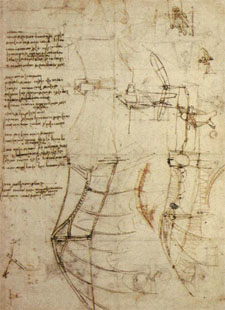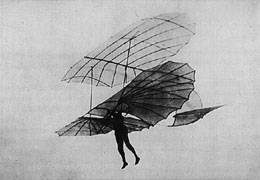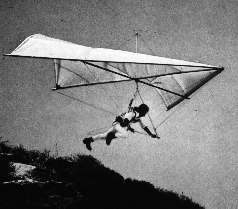MISSION SOARING - 33 YEARS OF HANG GLIDING
Thirty-three years! That covers the lion's share of the history of Hang gliding. And Mission Soaring Center has been there.
Pat Denevan, owner and founder of MSC, had read
about a bamboo and plastic do-it-yourself glider in Popular Mechanics
like the rest of us. Unlike the rest of us, he decided to actually build one. But an article in Joe Foust's "Low and Slow" newsletter convinced him that aluminum was the way to go. Armed with plans from Herman Rice's "Hang Gliding Bible", he headed to Los Angeles, CA, for the 1972 Turkey Day Fly-in, with the ulterior motive of a stop at Washington Supply Hardware, a Mecca of aerospace surplus including aluminum tubing. The Fly-in didn't happen, but there was plenty of action to check out at an ocean front dune called Dockweiller Beach, in El Segundo, CA. And Washington Supply sold Pat the last useable lengths of tubing. No one knew much about alloys or temper back then. One piece he purchased had the flexibility of overcooked spaghetti, useless for a hang glider. Pat and five friends salvaged what they could, built one glider, and it flew!
One glider just wasn't enough to go around, and crashes were eating their tubing supply in a hurry. Time to build more gliders! But the retail price of tubing was an "outrageous" price of $1.65 a foot. Pat did some searching until he located wholesale tubing for $.30 a foot, $1000.00 minimum order.

From DaVinci's Codex Atlanticus |
That was a little steep for one more glider. It also left him with a LOT of extra tubing. So in March 1973, Pat opened the garage doors of Northern California Hang Glider Supply, purveyors of aluminum. Requests for other parts soon led to the $150 complete airframe kit. For another $12.50 NCHGS supplied a 20' square of plastic sheeting and a roll of deluxe duct tape. Dacron sails were available by that time, but the quality varied and the result often wasn't as smooth as plastic. But plastic had a way of stretching in the heat and cracking in the cold. Take your pick and take your chances.
Many pilots wanted help building their glider kits and most wanted help flying them. So Pat was now a manufacturer, with a new name to match: Super Fly Sky Sails. Instruction was still haphazard, the nearsighted leading the blind. Super Fly began taking friends down to Sunset Beach to show them the ropes for fun. Everyone was busy searching for new flying sites. Pat was most interested in places where he could help people learn to fly. He was cruising down the coast on a trip to LA when he found a road leading to the dunes at Fort Ord. What a place! Training dunes and miles of coast to soar along. Soon Super Fly was heading to Marina Beach regularly and a formal teaching program was born.
Late in the seventies, hang gliding was evolving at warp speed, and Super Fly was no exception. Pat realized his first love was training, not manufacturing. He couldn't keep up with the likes of the Wills boys and, besides, his gliders only cost him about $100 more than he sold them for. Super Fly became a retailer, and hired experienced instructors.
Meanwhile, a club formed by Dave Kilbourne, Jim Diffenderfer, and other water-ski low kite enthusiasts was evolving into the Wings of Rogallo as they moved their flying from the delta to Coyote Hills near Newark. They began flying from the "Rondorosa" property above Milpitas, CA, into a little park
|

Otto
Lillenthal
|
called Ed Levin. Flying sites were opened and shut down almost monthly, it seemed. Coyote Hills. Mission Ridge. Then the Rondorosa. Open, then gone.
Pat decided it was time to move from Los Gatos closer to a flying site, but which one: Marina, or the East Bay? Fremont was a gamble, but reopening Mission or Ed Levin looked promising. So Super Fly became Mission Soaring Center in 1978, when it opened in new expanded quarters in Fremont's Mission district. There was even enough space for Wings of Rogallo club meetings.
Santa Clara County soon bought the ranchlands above Ed Levin and paved the way for renewed hang gliding activity. Instructors soon discovered how useful the park was for introducing new pilots gradually to advanced skills. Pat, first as WOR club president, then as USHGA Regional Director, continued to help with objective two: Mission Ridge (and some groundwork was laid for a more distant dream, Mt. Diablo). The Diablo Condors joined Pat in the Mission Ridge project and Jim Leech ran full tilt at the Diablo project, and suddenly, in 1983, we had two new flying sites in the Bay Area.
Hang Gliding was rapidly leaving its ground-skimming roots in the dust. We were discovering the intricacies of soaring and thermalling. The 360 degree turn was no longer considered advanced aerobatics. An afternoon of "go back up the hill until you stop crashing" had evolved into an unbelievable 10 lesson package! Instructors were now certified by the USHGA. Instructors were now taught how to teach. Pat was in his element here, and the Mission Soaring training program evolved rapidly. A MSC instructor, Jim Shaw, developed a major revision of the USHGA Instructor Certification Program, and conducted training seminars for new instructors.
By 1986, all this activity was straining the limits of the Fremont shop, so MSC moved to new digs in Milpitas, designed from the ground up to service hang gliding. We gained a showroom/classroom shaped to fit a set up gliders (including our unanticipated Dream 240 training behemoth), a harness trainer control bar simulator, a frame shop, sail repair floor, parachute packing and lofting space, and a harness repair area. These tools have allowed Mission Soaring Center to develop special superlite Dream
 Launching a standard Rogallo wing
Launching a standard Rogallo wing |
220 and 240 gliders, an innovation for training in light wind conditions. Our training harnesses were designed in house to minimize discomfort and optimize the semi-upright position we use for takeoff and landing. We've created field practice simulators to perfect skills away from the distracting variables of an actual flight. We've experimented with towing.
Theories of skills and training have been scrutinized constantly over the years. Only in the last year or two have we started to understand the fundamental dynamics of flying a hang glider, thanks to the insights gleaned from the Launch and Landing Clinic program. Pat has taken this info on the road, running ICP seminars across the country. He is presently working with Dennis Pagen, Michael Robertson, Glen Nicolette (chairman of USHGA Safety and Training), and others to revise again the ICP guidelines and training process for new instructors. The key to the enjoyment and safety of the sport is good training and skills. Was there any doubt?
To that end, Pat also envisioned a new USHGA publication,a newsletter devoted to training issues sent to all USHGA certified instructors. Most of what we learn as advanced pilots comes from other pilots on the hill, some of whom are actually trained instructors. The Instructor newsletter taps this "grapevine", spreading innovative ideas to all pilots.
And that brings us to 1999 and the modern Mission Soaring, the best Hang Gliding Shop in Milpitas. Looking back over 33 years of hang gliding, it's astonishing how far the sport has come. Mission Soaring Center is proud of its role in that evolution. We appreciate your support. Viva la revolucion

|
|
|
|
Modern aviation traces its heritage to the foot-launched gliders of Chanute, Lillienthal, Montgomery, and other aviation pioneers of the late 1800s. But aviation's history is predominantly one of powered flight. The joy of pure flying was quickly lost in the rush to motorize. In the late 1960's hardy pilots were attempting to recapture those heady early experiences by riding immense flat kites, towed behind boats, with marginal success and less control. Meanwhile, a retired NASA engineer, Francis Rogallo, was testing a controllable toy kite based on his steerable recovery system designed for the Gemini Space Program. The possibilities of a man-sized version of Rogallo's toy were noted, and the modern sport of Hang Gliding was born. Since then, the "kite" has evolved from bamboo and plastic into a sophisticated aluminum, dacron, and mylar flying wing. The sport has matured into a safer, relatively inexpensive, self-regulated form of sport aviation with much to offer anyone who loves flight and has a desire to share the domain of the hawks and eagles!
|
HOW IS IT DONE?
|
Flying a Hang Glider is an aerial dance. Twisting and shifting, you carve gentle pirouettes in the air, hardly aware of the wing over your shoulder. Most pilots lay prone, flying like superman in a secure fabric and webbing cocoon, suspended from the central balance point of the wing. Move your body by pulling or pushing on the triangular control frame, and the wing turns, climbs or dives in response. Its simplicity is its beauty. Move forward to dive for speed. Move backwards to slow up in a climb. Shift to the side to bank into a turn. You control your wing's movement in a visceral, active way that no airplane pilot has ever experienced. Takeoff and landing is accomplished sitting upright with the gear (your legs) down. You run down the launch slope with the glider floating above you until, at the right speed, it lifts you into the air. When you want to land, you skim across the landing field, then rotate the wing up and back to drop gently on your feet.
|
IS IT SAFE?
|
Any form of aviation has its risk. Hang Gliding is like most popular outdoor sports: it must be performed with the proper attitude toward safety and within the limits of equipment and pilot. State-of-the-art certified gliders, advanced instruction techniques, and the USHGA skills rating program have all helped to reduce the accident rate. Hang Gliding has a safety record superior to general aviation!
|
HOW DO YOU LEARN?
|
Modern instruction is a carefully developed progression of skill and knowledge, designed to take you smoothly from your first Bunny Hill glide to advanced soaring. Certified schools have designed their program around the USHGA Skills Rating Program. Each level you earn, by demonstrating new skills and knowledge, opens a door to more advanced fun and challenge. No one launches from a mountain top on their first day of instruction. Your first flights will skim a few feet off the ground on the Bunny Hill, with the help of training wheels for landing and an easy roll back to launch. During your first few lessons you will learn the basic skills of ground handling, launch, straight and level flight and landing. Perfecting these skills will earn the first skills rating - Beginner (Hang I). You will soon progress to higher hills and longer flights, learning turns and spot landings, encountering new sites and new conditions. With a Novice Rating (Hang 2), you will begin to experience the real challenges of Hang Gliding. At Ed Levin Park, you will gain experience on five progressively higher launches until you are ready for the top of the mountain, the 1750 foot Monument Peak launch. And soon enough that special day will come: a soarable day you can fly and fly until YOU want to land! After accumulating the necessary hours, flights, and skills, it's time to demonstrate your Intermediate (Hang 3) tasks to a USHGA Observer. Your reward is the freedom to fly a wide variety of new sites such as Fort Funston in San Francisco, Mount Tamalpais in Marin County, the Santa Lucia Mountains near Big Sur, and Slide Mountain near Lake Tahoe. The Advanced Rating (Hang 4) is earned through time and experience. You will be certified to fly any rated site in the world. Many pilots celebrate with a special flight from Glacier Point in Yosemite. You will become one of a special elite who have experienced the beauty of Yosemite from the air. You can now fly Mount Diablo, Mission Ridge, and the famous Owens Valley, home of some of the best cross country flying in the world and a record 243 mile flight! The Master Rating (hang 5) is a special honor for those pilots whose skills, contributions, and experience place them among the sport's best.
|
WHO FLIES HANG GLIDERS?
|
As you learn to fly, you will be introduced to a friendly, dedicated fraternity of enthusiasts. On the local level is the Wings of Rogallo, the world's oldest and largest hang gliding club with over 450 members. The club hosts monthly meetings where anyone with an interest in flying is welcome. We come to swap information, share flying related entertainment, and organize the task of running three Bay Area flying sites: Ed Levin in Milpitas; Mission Ridge in Fremont; and Mt. Diablo near Concord. The club maintains access roads at these parks, organizes site monitors and observers, and develops rules and procedures for flying. W.O.R organizes flying trips, picnics, and fly-ins. We operate a series of custom remote weather stations and a weekend soaring report you can access by phone. Pilots are represented on the national level by the United States Hang Gliding Association. The USHGA provides a forum for pilot issues, defines training programs and pilot proficiency requirements, sets policy for the sport, provides the tools and support to open and maintain flying sites, provides liability insurance coverage for individual pilots, sites, and events, sanctions competitions and records, and serves as our ambassador to the general public, the government, and the world hang gliding fraternity. Due to the professionalism of our organizations and the responsibility of individual pilots, we retain the privilege of self-regulation.
|
HANG GLIDING
|
We have hardly scratched the surface of the world of Hang Gliding. Hang Gliding can stimulate your interest and enthusiasm for many years. Every flight is a new challenge, demanding new skills and knowledge. The art of soaring coastal dunes and cliffs differs from mountain ridge soaring. Mountain thermal soaring is a chess game of skills and strategy. Cross-country flying will make you a meteorologist and introduce you to the world of Amateur Radio. And along the way you will learn to recognize the hawks and falcons that share the thermals with you. You will meet each day with new appreciation for the possibilities of wind and weather. And you will find a circle of friends who share a view of the world from a slightly different perspective.
|
|
 |
|




